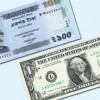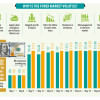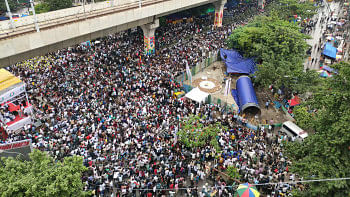Businesses for using multiple currencies

Bangladesh should cut its over-reliance on the US dollar and increase the use of other currencies such as the Chinese renminbi (RMB) in international trade to ease pressure in the foreign currency market, businesses said.
The suggestion came after the demand for US dollars from importers surged in the domestic market to settle imports, sending the reserves of the foreign currencies below $40 billion recently and driving up the value of the greenback to as high as Tk 112 per dollar recently from Tk 94 a few days ago.
"We have the option. We can use the Chinese currency at least for a temporary period to stabilise the forex market," said Md Saiful Islam, president of the Metropolitan Chamber of Commerce and Industry.
Islam submitted a proposal to the central bank governor last week asking him to introduce the Chinese RMB as the second currency in settling international payments.
"It will help save a lot of dollars that can be used in the normal time," he said.
In fact, the central bank in 2018 allowed banks to open foreign currency clearing accounts with the BB in the Chinese renminbi. Banks can open such accounts in the US dollar, the pound sterling, the euro, the Japanese yen, and the Canadian dollar as well.
Businesses argue that many countries are using the RMB in international trade as the currency has become convertible. Besides, some countries like Bhutan and Nepal are already using the Indian rupee as their second option to trade with India.
The recommendation from the businesses to use the RMB comes largely because China is the largest import destination for Bangladesh.
Bangladesh imports industrial raw materials, intermediate goods, spare parts, cotton, machinery, chemicals, and woven and knitted fabrics worth $15 billion a year.
Products worth $10 billion come from India.
According to Islam, using other currencies in international trade is for a temporary period, not permanently.
Mohammad Ali Khokon, president of the Bangladesh Textile Mills Association, echoed Islam.
"There is nothing wrong with the currency convertibility in the RMB. It can be done for a temporary period to save the economy. The RMB can be an option to keep the supply chain stable"
Textile millers are one the largest importers of Chinese products.
"We want the central bank to introduce the RMB as the second option for international trade because we import a lot of goods from China," said Mohammad Hatem, executive president of the Bangladesh Knitwear Manufacturers and Exporters Association.
A lot of the RMB should be kept in the vault of the central bank to use them in times of emergency, he said.
"Exporters will not lose any penny even if the RMB is used as the US dollar will determine the exchange rate," he added.
Md Shahidullah Azim, senior vice-president of the Bangladesh Garment Manufacturers and Exporters Association, says the RMB can be introduced as a test case.
He, however, favours the introduction of the Chinese currency only to settle import payments, instead of opening it for all other sectors.
Rizwan Rahman, president of the Dhaka Chamber of Commerce and Industry, said multiple currencies can be introduced for international trade transactions as the dollar has become dearer.
The RMB can be an option as Bangladesh has had an agreement with China since 2017 on the use of the currency, Rahman said.
He said Bangladesh imports nearly $15 billion worth of goods from China and exports about $1 billion worth of products.
So, the RMB can be used to settle import payments equivalent to at least $1 billion, said Rahman.

 For all latest news, follow The Daily Star's Google News channel.
For all latest news, follow The Daily Star's Google News channel. 







Comments